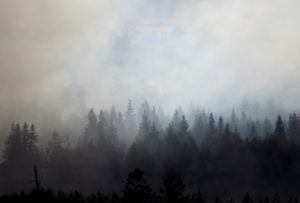ASHEVILLE, NC – May 31, 2023 – Last week, I saw a lot of haze whenever I looked at the mountains around Asheville and when I hiked Mount Pisgah with an out-of-town guest. That day was sunny with few clouds in the sky. Temperatures were perfect for a hike, in the high 60’s. There were hardly any people on the trail in the late afternoon. We took our time and hiked the 1.2-mile route beginning at the almost 5,000-foot trailhead and ending at the 5,721-foot peak. An observation deck at the top offered a 360-degree panoramic view of the Pisgah National Forest. Two people on the deck blamed the Alberta wildfires out west for the hazy visibility.
Wildfires produce greenhouse gases (which contribute to warming of the earth and climate change) and other air pollutants. The greenhouse gases include carbon dioxide and methane. The other air pollutants include nitrogen oxides, carbon monoxide, and large amounts of fine particulate matter (PM). PM2.5 consists of microscopic pieces of solid or liquid droplets, 2.5 microns or less in diameter. If the smoke sinks to ground-level then a build-up of ozone can develop from the chemical reaction of some of the pollutants in the presence of sunlight.
Studies have shown that breathing air pollutants can lead to health problems. PM2.5 particles can cause premature death and heart and lung disease. Ground-level ozone can aggravate lung disease and cause breathing problems.
The fire season in western Canada has been more intense than usual. Drought and lightning strikes caused more than 100 active wildfires in the Alberta province. These have been aggravated by a heat wave. Beginning 2 weeks ago, the western Canadian wildfires sent polluted air over eastern Canada and the United States from Maine to North Carolina, traveling almost 2-thousand-miles along the jet stream. Last week, the smoke shifted to the Rocky Mountains and the Midwest.
By May 21st, much of these areas have had air quality alerts for residents with heart and lung issues. According to the North Carolina Department of Environmental Quality, the air quality of Asheville had been in the moderate category on May 11, 15, and from the 20-25, 6 days in a row. Air quality in the moderate range is one level lower than good. There are 4 levels beneath moderate. Moderate air quality is generally safe for most people to breathe, but may affect a small number of people who already have heart and lung disease.
Persons with heart and lung problems should consider checking the air quality index report daily. In the event of moderate or worse air quality, susceptible individuals should consider wearing a face mask, limiting outdoor activities, or staying inside.
Listen to the full report below:
Contact: Dr. Dick Needleman, Health reporter, 103.3 AshevilleFM, [email protected]
More Posts for Show: Asheville FM News Hour
